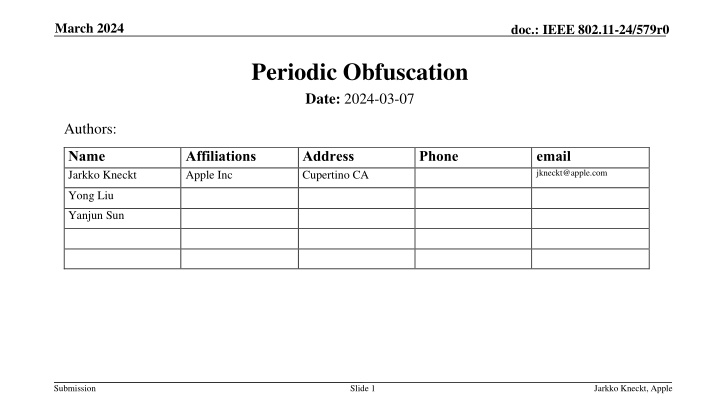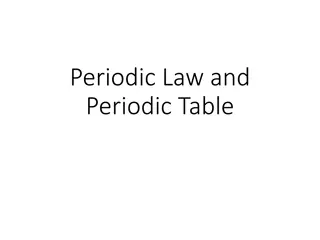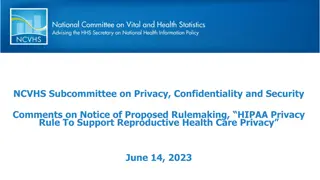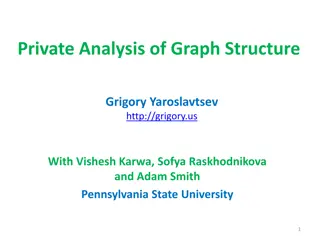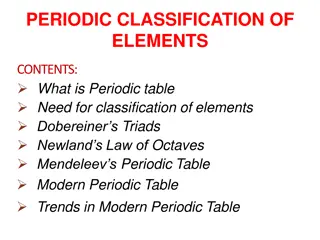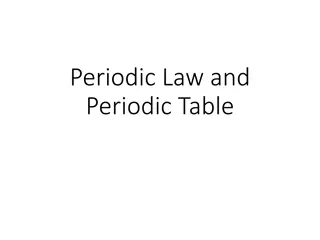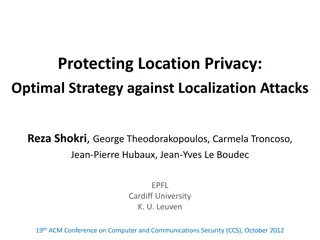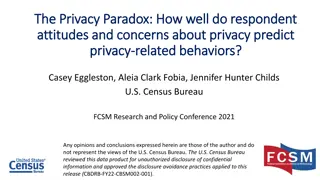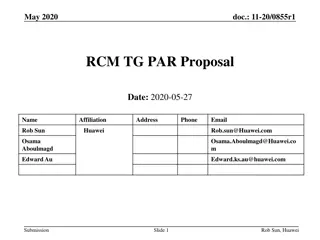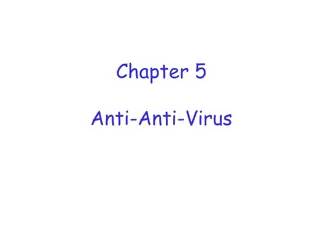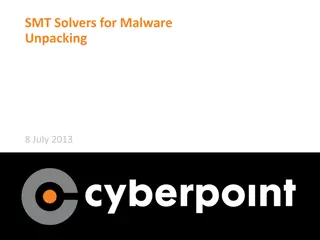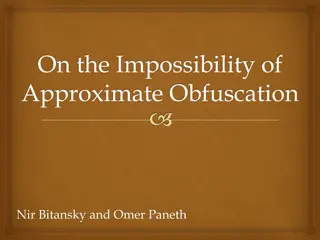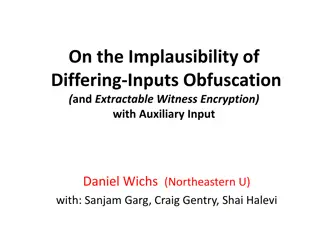Periodic Obfuscation Proposal for Enhanced Privacy Protection
The document discusses a proposal for periodic obfuscation to enhance privacy protection in post-association states of IEEE 802.11 networks. It introduces a scheme allowing for shorter intervals of AID and MAC Header obfuscation, improving privacy safeguards beyond current 15-minute intervals. Various obfuscation alternatives are explored, focusing on BSS-specific strategies and address offset changes. The proposal also details examples of AID value obfuscation and MAC Header obfuscation techniques to mitigate tracking risks.
Download Presentation

Please find below an Image/Link to download the presentation.
The content on the website is provided AS IS for your information and personal use only. It may not be sold, licensed, or shared on other websites without obtaining consent from the author.If you encounter any issues during the download, it is possible that the publisher has removed the file from their server.
You are allowed to download the files provided on this website for personal or commercial use, subject to the condition that they are used lawfully. All files are the property of their respective owners.
The content on the website is provided AS IS for your information and personal use only. It may not be sold, licensed, or shared on other websites without obtaining consent from the author.
E N D
Presentation Transcript
March 2024 doc.: IEEE 802.11-24/579r0 Periodic Obfuscation Date: 2024-03-07 Authors: Name Jarkko Kneckt Affiliations Apple Inc Address Cupertino CA Phone email jkneckt@apple.com Yong Liu Yanjun Sun Submission Slide 1 Jarkko Kneckt, Apple
March 2024 doc.: IEEE 802.11-24/579r0 Abstract 802.11bi has key requirements for AID and MAC Header obfuscation for improved privacy protection in post association state. 802.11bi has got proposals to obfuscate every 15 minutes. This obfuscation interval is not sufficient to prevent STA tracking in some use cases. This submission defines periodic obfuscation scheme which enables STAs to obfuscate AID and MAC Headers in much shorter interval and therefore provides better privacy protection. Submission Slide 2 Jarkko Kneckt, Apple
March 2024 doc.: IEEE 802.11-24/579r0 Obfuscation Alternatives Obfuscation Alternative AID obfuscation Obfuscation Setup Signaling NOTE Individual Signaled by the AP Obfuscation setup signaling per obfuscation Large signaling overhead, if frequent obfuscations. Current proposal is to obfuscate every 15 minutes Group AP coordinated signaling, multiple messages per obfuscation Periodic BSS specific AID offset BSS specific schedule, obfuscation at TBTT No signaling per obfuscation MAC Header obfuscation (XOR with offset) is the same on all alternatives Jarkko Kneckt, Apple Submission Slide 3
March 2024 doc.: IEEE 802.11-24/579r0 Proposal: BSS-Specific Periodic Obfuscation MAC Header and AID offset are changed at a BSS specific interval, e.g., at TBTTs of TIM or DTIM Beacon The AP and STAs may prepare the new addresses prior to offsets change At the offsets change, frames with old or new addresses are received for a short period Submission Slide 4 Jarkko Kneckt, Apple
March 2024 doc.: IEEE 802.11-24/579r0 Proposal: AID Obfuscation Example of AID values obfuscation: AP assigns a range of AID values (100 500) to obfuscating STAs Obfuscating STAs use the same BSS specific AID Offset, so there are no AID collisions AIDObfuscated = 100 + (AIDAssigned + Offset) MOD 400 An associated STA may change its AIDAssigned by using explicit individual obfuscation Jarkko Kneckt, Apple Submission Slide 5
March 2024 doc.: IEEE 802.11-24/579r0 Proposal: MAC Header Obfuscation All obfuscation schemes obfuscate OTA MAC Headers in the same way Obfuscation setup signaling and obfuscation frequency are scheme specific MACHeader[N]OTA= MACHeader[N]CLEAR XOR (Offset[N] AND ObfuscationMask[N]) The offset is created with a one-time calculation by using STA-specific key and nonce 802.11bi specification defines the obfuscated fields, i.e., specifies the Obfuscation Mask N is the position of the obfuscated bit in the MAC Header Some Frame Control fields are transmitted clear OTA to enable all receivers to detect: Frame type and subtype Whether the MAC Header includes Address 4 and HT-Control fields Submission Slide 6 Jarkko Kneckt, Apple
March 2024 doc.: IEEE 802.11-24/579r0 Thank you! Benefits of the Periodic Obfuscation Excellent STA privacy Obfuscated addresses, AID, SN, PN, etc. fields are very complicated to track Throughputs and transmission delays are not affected Periodic obfuscation causes no additional delays to the frame transmissions or receptions No additional transmitted fields or additional frames No additional wake-ups or frame transmissions that increase non-AP STA power consumption Submission Slide 7 Jarkko Kneckt, Apple
March 2024 doc.: IEEE 802.11-24/579r0 ANNEX, This submission meets 16 802.11bi Requirements [23/892r3] # CPE Requirements (Inherited to BPE STAs as basic requirements) 11bi shall define a mechanism for a CPE Client and CPE AP to establish the CPE Client s DS MAC Address without the CPE Client s DS MAC Address being transmitted in the clear 11bi shall define a mechanism to randomize over the air MAC address of the 11bi non-AP STA or 11bi non-AP MLD (carried in Address 1 field or Address 2 field of the MAC header) during BSS transition.(related to R6) 3111bi shall define a mechanism for CPE Clients and CPE APs to encrypt or obfuscate (TBD) a subset of MAC Header fields (specific fields TBD) 11bi shall define a mechanism for a CPE Client to initiate changingits own OTA MAC Address used with a CPE AP in Associate STA State 4 without any loss of connection. 11bi shall define a mechanism for a CPE AP to initiate changing the OTA MAC Addresses of a set of associated CPE Client sin the BSS (those CPE Clients in Associate STA State 4) without any loss of connection. 11bi shall define a mechanism for a CPE Client and CPE AP to change the transmitted SN and the scrambler seed on downlink and uplink to uncorrelated new values in Associate STA State 4, without any loss of connection when the OTA MAC address of the CPE Client is changed. 11bi shall define a mechanism for a CPE Client and CPE AP to change the transmitted PN on downlink and uplink to uncorrelated new values in Associate STA State 4, without any loss of connection when the OTA MAC address of the CPE Client is changed. 11bi shall define a mechanism for a CPE Client and CPE AP to change the CPE Client s AID to an uncorrelated new value in Associate STA State 4, without any loss of connection when the OTA MAC address of the CPE Client is changed. # BPE Requirement (Additional requirements for BPE STAs) 11bi shall define a mechanism for a BPE Client and BPE AP to establish a BPE AP s identifier (TBD), (48 bit-value) without the identifier being transmitted in the clear. This will likely be the same mechanism as used in Req 12. 11bi shall define a mechanism for a BPE AP and a BPE Client to change the OTA MAC addresses, SN and PN they use for unicast transmissions. BPE Clients and BPE APs shall reset the Scrambler Seed on individual and group addressed frames when a TA MAC address is changed. 12 BPE AP 19 MAC address 25 BPE MAC address change while associated 39 MAC Header 41 7 11bi shall define a mechanism for BPE Clients and BPE APs to encrypt or obfuscate (TBD) a subset of MAC Header fields (specific fields TBD). 11bi shall define a mechanism for BPE Clients and BPE APs to encrypt the +HTC field and the HT Control field. 11bi shall define a mechanism for a BPE Client and BPE AP to obfuscate the transmitted TID to an uncorrelated new value on downlink and uplink to new values in Associate STA State 4, without any loss of connection. 11bi shall define a mechanism for a BPE AP to obfuscate the RA, SN and PN of the group frames to avoid BPE AP tracking. BPE MAC Header 45 8 MAC address change while associated BPE Control A- 46 9 BPE TID 44 10 BPE Group frames 40 11bi shall define a mechanism to obfuscate affiliated BPE APs parameters so that eavesdropping STAs cannot determine that they belong to the same AP MLD. BPE MLD AP 11 38 Submission Slide 8 Jarkko Kneckt, Apple
March 2024 doc.: IEEE 802.11-24/579r0 ANNEX: Transmission Flow with Obfuscation OTA MAC Headers are obfuscated Offset is XORred on MAC Header Offset is calculated by the transmitter and receiver BA uses the obfuscated values The offset remains the same until explicit or periodic change No offset change during an ongoing TXOP, because eavesdropper would detect how the addresses change Jarkko Kneckt, Apple Submission Slide 9
March 2024 doc.: IEEE 802.11-24/579r0 ANNEX: Explicit Obfuscation Alternatives Individual obfuscation defines signaling for an associated (State 4) STA and AP to setup a TSF time to change the MAC Header offset and AID The STA requests and AP accepts the obfuscation Obfuscation has no impact to association, BA setups, SCS, etc. Target is to obfuscate every ~ 10 minutes Group obfuscation requires many steps of AP and STA coordination: 1. AP advertises obfuscation time 2. STA requests to obfuscate at the advertised time 3. AP informs requesting STA(s) whether the obfuscation will happen, i.e., whether the number of participating STAs is over a BSS specific threshold 4. At the agreed time, the MAC Headers, addresses and AIDs of the participating STAs are obfuscated Target is to obfuscate every ~ 10 minutes Large number of STAs obfuscates at the same time, which makes STA tracking more difficult Jarkko Kneckt, Apple Submission Slide 10
March 2024 doc.: IEEE 802.11-24/579r0 ANNEX: Offset Calculation Offset value = GCMP256 ( 802.11bi MAC Header Obfuscation. Protecting privacy of the STAs and APs | POK | Nonce) CPE STA and CPE AP use Pairwise Obfuscation Key (POK) for the STA specific offset creation The Nonce consist of link specific: Transmitter OTA address (A2) TSF of the offset change time The encrypted plaintext is defined in 802.11bi specification and has value: 802.11bi MAC Header Obfuscation. Protecting privacy of the STAs and APs Submission Slide 11 Jarkko Kneckt, Apple
